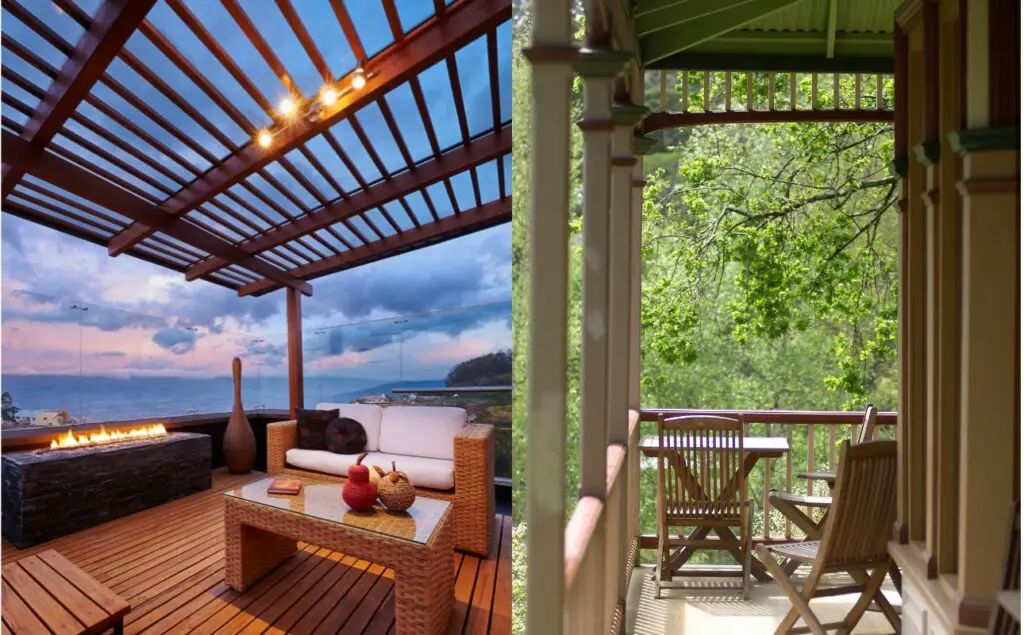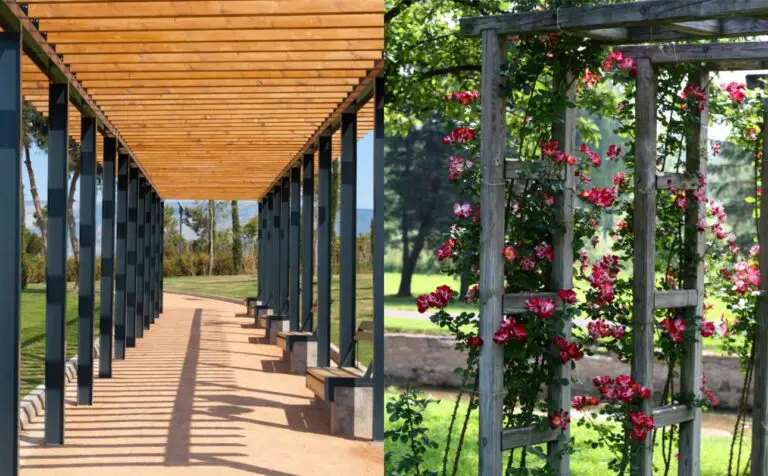A pergola and a verandah are two common outdoor structures that are used to enhance the appearance and functionality of a home. While they may look similar, they have distinct differences in their design, purpose, and functionality.
Understanding these differences can help you choose the right structure for your needs.
We will explore the key differences between pergolas and verandahs, and how they can be used to create a beautiful outdoor space for your home.

Comparison Chart
Here is the comparison chart for Pergolas vs Verandah, this table will help you to decide the actual difference between them.
| Pergola | Verandah | |
| Definition | Outdoor structure with an open roof and crossbeams, often used for shading or as a garden feature | Covered outdoor structure attached to a house, usually with a roof and open sides |
| Design | Can be freestanding or attached to a house or building, usually has an open roof with crossbeams, and may have optional retractable shades or curtains | Always attached to a house or building, usually has a solid roof and open sides, may have railings or columns |
| Purpose | Provides partial shade and visual interest to outdoor areas such as patios, decks, or gardens | Provides a covered outdoor space for relaxing, entertaining, and enjoying the view |
| Materials | Can be made of wood, vinyl, fiberglass, or metal | Typically made of wood, but can also be made of metal or vinyl |
| Cost | Can range from a few hundred dollars to several thousand dollars depending on the size and materials used | Generally more expensive than pergolas due to the added structural elements and roofing materials |
| Maintenance | Requires occasional cleaning and sealing or staining to maintain its appearance and protect against weather damage | Requires regular cleaning and maintenance to keep the roof and gutters clear of debris and prevent water damage |
| Versatility | Can be customized with optional features such as built-in seating, lighting, or retractable shades | Offers less design flexibility but can be enhanced with features such as ceiling fans or outdoor heaters |
| Aesthetic appeal | Can add a decorative element to outdoor spaces and enhance curb appeal | Enhances the architectural style of a home and provides a functional outdoor living space |
| Overall functionality | Primarily used for shade and as a decorative feature | Provides a covered outdoor living space for relaxation, entertaining, and enjoying the view |
Pergolas vs. Verandah: What are the Key Differences?
Pergolas and Verandahs have distinct differences in their size, purpose, design, cost, and maintenance requirements.
Pergolas are smaller, primarily used for shading and as a decorative feature, and have an open roof with crossbeams. Verandahs are larger, provide a functional covered outdoor living space, and have a solid roof with open sides.
Size Comparison
Pergolas are typically smaller in size than verandahs, and their size can vary depending on the space available and the intended use. They are often used to create a focal point in a garden or outdoor area and can range in size from a small canopy over a bench or swing to a large structure covering an entire patio.
Verandahs, on the other hand, are usually larger and are attached to a house or building. They provide a covered outdoor living space that can be used for relaxation, entertaining, and enjoying the view.
Purpose Comparison
Pergolas are primarily used for shading and as a decorative feature. They can add visual interest to outdoor spaces such as patios, decks, or gardens, and provide a partially shaded area for relaxation or entertaining.
Verandahs, on the other hand, provide a functional outdoor living space that is covered and attached to a house or building. They are ideal for enjoying the view, entertaining guests, or simply relaxing outdoors in a protected environment.
Design Comparison
Pergolas typically have an open roof with crossbeams and can be freestanding or attached to a house or building. They can be customized with optional features such as built-in seating, lighting, or retractable shades.
Verandahs, on the other hand, are always attached to a house or building and have a solid roof with open sides. They may have railings or columns to enhance their architectural style.
Cost Comparison
The cost of a pergola can vary widely depending on its size and the materials used. A basic DIY pergola kit can cost a few hundred dollars, while a custom-built, larger pergola made of high-quality materials can cost several thousand dollars.
Verandahs are generally more expensive than pergolas due to the added structural elements and roofing materials. The cost of a verandah can range from several thousand dollars to tens of thousands of dollars, depending on the size, materials, and design.
Maintenance Comparison
Pergolas require occasional cleaning and sealing or staining to maintain their appearance and protect against weather damage. The frequency of maintenance will depend on the type of material used, with wooden pergolas requiring more maintenance than those made of vinyl or metal.
Verandahs, on the other hand, require regular cleaning and maintenance to keep the roof and gutters clear of debris and prevent water damage. They may also require periodic inspections for structural integrity and to ensure that they are securely attached to the house or building.
How to Choose the Right One?
When it comes to choosing between a pergola and a verandah, there are several factors to consider to ensure that you select the right one for your needs.
Here are some key considerations to keep in mind:
- Purpose and Function
Think about how you plan to use the outdoor structure. If you are looking for a simple decorative element or a shaded area for a garden or patio, a pergola may be the right choice.
If you want a functional outdoor living space that is attached to your home and provides protection from the elements, a verandah may be the better option.
- Location
Consider the location where you want to install the outdoor structure. If you have limited space or a smaller outdoor area, a pergola may be the more practical choice.
If you have a larger outdoor space or want an extension of your indoor living space, a verandah may be the better choice.
- Size and Shape
Think about the size and shape of the outdoor structure that you want. Pergolas come in a range of sizes and shapes, from simple rectangular structures to more elaborate designs with curved or angled roofs.
Verandahs are typically attached to the house or building, so their size and shape will be determined by the available space and the architectural style of the house.
- Design and Style
Consider the design and style of the outdoor structure that you want. Pergolas can be customized with a range of features, such as built-in seating, lighting, or retractable shades, and can be made of a variety of materials to match your outdoor decor.
Verandahs are typically designed to match the architectural style of the house and can also be customized with features such as railings, columns, or decorative trim.
- Budget
Consider your budget when selecting an outdoor structure. Pergolas are generally less expensive than verandahs, but the cost can vary widely depending on the size, materials, and design.
Verandahs are typically more expensive due to the added structural elements and roofing materials.
- Climate
Consider the climate in your area when selecting an outdoor structure. If you live in an area with harsh weather conditions, such as high winds or heavy snowfall, a verandah may be a better choice as it provides more protection from the elements.
If you live in a more temperate climate, a pergola may be a better option as it provides some shade without blocking out the sun completely.
The Bottom Line
After exploring the differences between pergolas and verandahs, it’s clear that both structures have their own unique features and benefits.
Pergolas are perfect for creating a decorative focal point in an outdoor area, while verandahs provide a functional living space that is attached to your home.
When choosing between the two structures, there are several key factors to consider.
The purpose and function of the structure, the location where it will be installed, the size and shape, the design and style, the budget, and the climate all play an important role in making a decision that is right for you.





